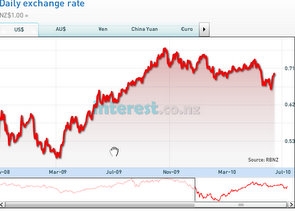
 By Mike Jones
By Mike Jones
The NZD has started the week off on a firm footing. NZD/USD poked its head above 0.7000 overnight for the first time since May 19.
Yesterday’s April retail sales data was about as weak as markets expected. Overall sales dipped 0.3%, while the ex-auto measure slipped 0.2%, from the solid recoveries posted in March. Smoothing through the (ongoing) ups and downs, the trend remains virtually sideways.
However, further evidence NZ consumers are keeping their wallets on a tight leash did little to stymie gains in the NZD overnight. Various reassurances the global economic recovery remains firmly on track buoyed demand for ‘risky’ assets like the NZD.
European industrial production data was fairly upbeat, rising to 9.5%y/y in April (8.7% expected) and St. Louis Fed President Bullard suggested the global recovery “seems unlikely to be derailed” at this point.
Global stock markets posted their fourth consecutive day of gains and commodity prices continued to claw back some of May’s sharp losses. The CRB index (a broad index of global commodity prices) rose 1.6%, to be 4.5% above its May lows.
Ratings agency Moody’s’ downgrade of Greece’s sovereign debt rating to ‘junk’ status appeared to do little to disrupt the more buoyant global sentiment. Increasing confidence the global recovery will be sustained spurred renewed demand for ‘growth-sensitive’ currencies like the NZD overnight.
Indeed, solid demand from both real-money and speculative accounts saw NZD/USD flirt with 0.7000 for the first time in four weeks. Our base case remains that NZD/USD should continue to edge higher in coming weeks, reflecting positive domestic factors (lofty commodity prices and expectations of more RBNZ rate hikes) as well as further gradual repair in global risk appetite. But it’s likely to be a case of two steps forward and one step back.
Investor sentiment remains fragile and further episodes of risk aversion should be expected. Short-term support is eyed towards 0.6850. Keep an eye out for today’s REINZ (nationwide) housing data for May, due to be released at 10am.
Majors
The USD weakened against most of the major currencies overnight as firming risk appetite saw demand for “safe-haven” currencies dry up. Over the past few sessions, worries about the European sovereign credit crisis have faded somewhat, restoring optimism about the global economic recovery. Risk appetite has recovered in turn, reintroducing downward pressure on the “safe-haven” currencies like the USD and JPY.
Overnight, gains in the major currencies were led by a further short squeeze in the EUR. Eurozone industrial production expanded at a more rapid pace than expected in April (0.8%m/m vs. 0.5% expected). In fact, the annual increase (9.5%) was the largest since records began in 1991. In addition, Spanish officials peppered the news wires with assurances Spain does not need to access emergency funds, further allaying sovereign solvency fears.
EUR/USD climbed from below 1.2200 to almost 1.2300, keeping the USD on the back foot for most of the night. A fourth consecutive day of gains on global stock markets saw ‘growth-sensitive’ currencies like AUD, NZD and GBP continue to claw back early-June’s sharp losses. Confidence received a further leg-up from comments from St. Louis Fed President Bullard that “the global recovery at this point looks very strong and seems unlikely to be derailed”.
European bourses posted gains of 0.7-2.0% and the S&P500 is about flat. The VIX index (Wall St’s so-called ‘fear gauge’) slipped from 29% to 28 % (long-run average 22%). Nonetheless, stocks and ‘growth-sensitive’ currencies ended the night off their highs. Risk appetite was knocked late in the session by ratings agency Moody’s decision to downgrade Greece’s sovereign debt rating four notches to ‘junk’ status (Ba1). GBP was the night’s best performing currency.
While in part this reflects GBP’s recent poor performance, some good news on the UK’s whopping government debt burden also buoyed GBP sentiment. The newly created Office for Budget Responsibility (OBR) forecast state borrowing would fall a little faster than originally thought. Along with a generally weaker USD, this propelled GBP/USD from around 1.4600 to 1.4750. However, the big picture is that the scale of the fiscal UK’s challenge set out by the OBR forecasts is not terribly different to that presented in the March Budget. As a result, a push through resistance towards 1.4920 looks a bridge too far for GBP/USD ahead of next week’s Budget.
* Mike Jones is part of the BNZ research team. All its research is available here.
No chart with that title exists.
We welcome your comments below. If you are not already registered, please register to comment.
Remember we welcome robust, respectful and insightful debate. We don't welcome abusive or defamatory comments and will de-register those repeatedly making such comments. Our current comment policy is here.